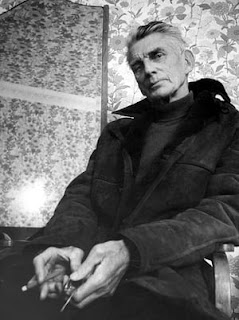'Proust is the godfather of fashion': what writers' clothes reveal about them
The title reads like a provocation: Legendary Authors and the Clothes They Wore. What? Shouldn't authors, especially "legendary" ones, be exempt from fashion scrutiny? Surely we should look at their words, not their outfits. If they produced great works of art, who cares how they dressed?
"When I sat down the first morning and started writing about Samuel Beckett, I thought: 'Oh, my goodness. Am I doing something completely outrageous?'" says the book's author, Terry Newman, who teaches fashion journalism at the University for the Creative Arts, Epsom. As it happens, she soon discovered that Beckett was a great place to start: he carried a Gucci bag and loved Clarks Wallabee shoes.
Newman's book is full of these crossovers between literature and fashion. There are obvious examples, such as Joan Didion, who appeared in a Céline campaign in 2015, and Dorothy Parker, whose writing career began at Vogue. But some alliances are more surprising. Gertrude Stein, with her monkish hair and opulent brooches, exchanged postcards with couturier Pierre Balmain. Vivienne Westwood was inspired by Joe Orton, and pretty much everyone was inspired by Proust. "Oh, Proust!" Newman says wearily. "He is the godfather of fashion. That 70s disco crowd was all so obsessed with him." Especially Yves Saint Laurent. This is unlike any Proust criticism I have heard.
Living authors are underrepresented. Zadie Smith is here, as is Donna Tartt. But there is no Stephen King, with his curated casual look, and Karl Ove Knausgaard could feel unappreciated with only a brief entry in the "hair" section. Chimamanda Ngozi Adichie is another omission since she has a clear look based around graphic dresses. Her 2012 TED talk, We Should All Be Feminists, became a slogan on a Dior T-shirt.
No one questions the link between fashion style and artistic style for visual artists or actors or musicians, yet the idea seems controversial for authors. The writing-in-pyjamas trope is partly to blame. However, this motif is itself misleading. Writers like to say that they spend all day in sweatpants, but it would be wrong to see this as a dereliction of style. Often, the scruffiness is a way to preempt high expectations of what you are about to produce, to trick yourself into seeming unhopeful. It can be good to feel a bit undone. Who really thinks they will write their best if they go to the page fully clothed?
But writers don't spend all their time at a desk. They go into the world as authors, and, when they do, there may well be continuity between writing style and clothing style. "Strong voice" – that commodity so prized by agents and editors – is the verbal equivalent of a strong look. It follows that an author's style might unfold seamlessly from their wardrobes to their books.
"When people talk about fashion, they think of it as frivolous," Newman says, although it never seemed so to her. She grew up loving clothes and books. And if you love both, you know that it is possible to critique an outfit just like a sentence. The Booker-longlisted novelist Ned Beauman plays with volume in his prose and dress (he likes Rick Owens). Donna Tartt cultivates sharp angles in her bobbed hair, crisp collars and many-cornered sentences.
Sometimes, a style can reinforce a writerly image and help to sell books, as it did for Ernest Hemingway, Tom Wolfe, Tartt herself – whose first author photo showed her severely bobbed in a snowy graveyard – or David Foster Wallace. His sports socks, trainers and very short shorts are the closest things to the mythical writer's tracksuit in Newman's book, but the mishmash doesn't look effortless. As befits his prose, every item of clothing looks like a footnote to some other outfit.
As Wallace knew, style is inescapable. You cannot opt out of it, in clothing nor in writing. All you can do is to appear not to care. But, of course, that would be just another style.
Legendary Authors and the Clothes They Wore by Terry Newman is published on 27 July by Harper Design (£20). To order a copy for £17, go to bookshop.theguardian.com or call 0330 333 6846. Free UK p&p over £10, online orders only. Phone orders min p&p of £1.99.
| Evernote helps you remember everything and get organized effortlessly. Download Evernote. |








No comments:
Post a Comment